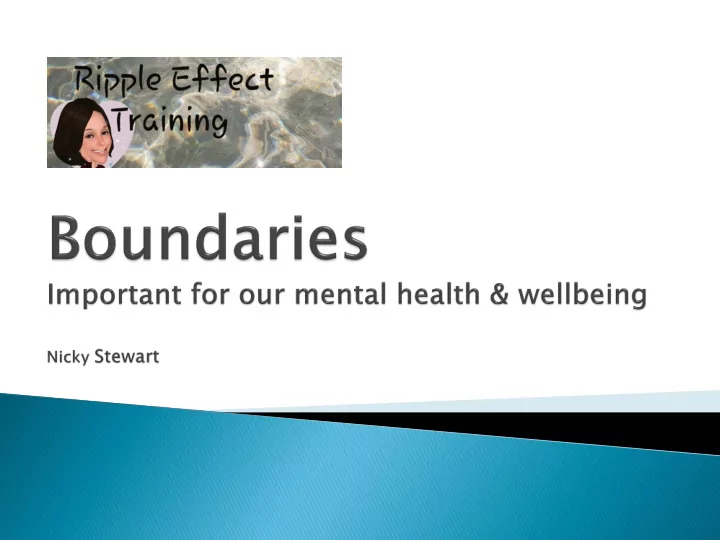

Your facilitator: BACP Accredited Counsellor Private Practice and School counsellor Integrative approach INSET training Wellbeing programme MHFA England Youth & Adult Instructor Past placements include:
Group discussion or sole reflective practice? Create a group agreement Option to leave the room Signpost support available outside the group
Workshop Aims • Understand how boundaries are essential to healthy relationships and a healthy life. • Work on how you set and sustain boundaries • Understand how they are an important part of establishing our identity, as well as being crucial for our mental health and wellbeing . • Explore the different types of boundaries. • Understand how healthy boundaries are a crucial part of self-care in all aspects of our lives.
An emotional or physical distance you have between yourself and a person/task/feeling so that you do not become overly enmeshed or too detached Work-related boundaries - how much of yourself you give to your career and how you form relationships with managers, colleagues, parents and pupils.
"Setting Boundaries" is a life skill that has been recommended by therapists, self-help authors and support groups since the mid 1980's. It is the practice of openly communicating, asserting, and defending personal values. The term "boundary" is a metaphor. "In bounds" means acceptable to you. "Out-of-bounds" means unacceptable. R.Skip Skip Joh ohnson son (2018 018)
Types of Boundaries 1. Physical : (eg a plaster on a cut; clothing on your body; fence around your house..) 2. Mental : Your thoughts and opinions 3. Emotional: Your feelings – expression/respression. Model good emotional regulation.
To practice self-care and self-respect To communicate your needs in a relationship To make space and time for positive interactions To set healthy limits
FEAR (of rejection/abandonment) GUILT NOT TAUGHT HEALTHY BOUNDARIES CONFRONTATION SAFETY CONCERNS
“In work or in our personal relationships, poor boundaries lead to resentment, anger, and burnout” (Nelson, 2016).
Addiction: unpredictability Mental ill health (Narcissistic personality disorder – may have a poor sense of self and do not recognise that others are not extensions of them. Borderline personality disorder (BPD) – Now known as Emotionally Unstable personality disorder) Co-dependency: putting your needs down and being excessively preoccupied with the needs of others Dysfunctional Families: Child attuned to needs of parent or Parent unhealthy self-sacrificing in child's needs Unequal power relationships: domestic abuse
Dual relationships..
Choose a picture from the selection which you are drawn to. Share your image with the group and why this resonated with you?
Creative work Draw a picture of a house, tree and a person. Imagine you see your boundaries as a fence around your house – how does this look?
I invite you to reflect on your drawing. Explore the following about your TREE : • What size if your tree? How do you deal with your anger? How significant do you feel? • How is your tree shaped? • Is your tree grounded? How do you deal with stress? Explore the following about your PERSON: • How are the arms? Arms represent our ability to ‘hold’ a situation and can be used to change or control the surrounding environment. • How are the feet/legs? Feet can represent our interpersonal mobility • How is the head? How we intellectualise and express ourselves mentally • How is the face? How do you express your emotions? • How are the shoulders? Do you shoulder equal responsibility, do you feel the need to be ‘strong’, are you hostile towards others?
I invite you to reflect on your drawing. Explore the following about your HOUSE : • Does your picture contain at least one door, one window, one wall, a roof and a chimney? • Have you added shrubs, flowers, a walkway? How structured do you like your environment? • Do you have a chimney? Does it have smoke? How do you express tension? Do you have conflicts with male figures? • Does your house have a door? Does it meet the floor? Is it open? – how do you receive warmth from the outside world? • Do you have a fence around your house? How do you protect yourself emotionally? • Does your house have guttering? If so, how trusting are you of others? • Where does your house appear on the page? How do you view a home, from which perspective? • How is your roof shaped? How do you shelter yourself? • Does your house have a walk way? What size/shape is it? How accessible or friendly are you? • Walls? How are these? Vertical, strong? How do you see yourself? • Windows? On the ground floor only? How do you view your reality? Curtains? How reserved or controlled are you? Are they bare? How direct or blunt are you in your communication?
The End – Thank you
References • https://en.m.wikipedia.org/wiki/Personal_boundaries • Where to Draw the Line: How to Set Healthy Boundaries Every Day Paperback – 31 Aug 2000, by Anne Katherine • https://www.wikihow.com/Set-Boundaries-at-Work • https://www.therapistaid.com/therapy-worksheet/boundaries-psychoeducation-printout • https://positivepsychologyprogram.com/great-self-care-setting-healthy-boundaries/ • Oster. G.D & Gould, P. (1987) Using Drawings in Assessment and Therapy, Brunner/Mazel Publishers, New York
Recommend
More recommend